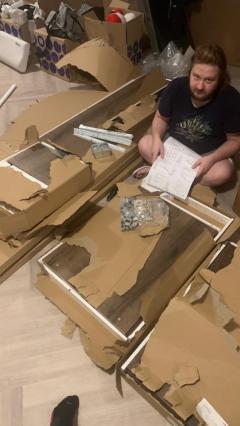
Among people who create websites or apps there's an understanding that UX, user experience, is massively important. We know that most users either don't have the technical knowledge to use software that isn't intuitive, or they simply don't have time to be bothered to get to know an app that isn't easy to use (and they have many alternatives to switch to).
So I'd think that ease of use of one's products is a common concern among companies of all industries, right? Well, I then moved to a new place and had to assemble a lot of furniture… What an absulute UX nightmare it was!
I'll only focus on one – most terrible – example: the wardrobe. Cause the amount of awful compared to how easily it could've been fixed is just astonishing there.
Our wardrobe came in 9 huuuge cardboard boxes. It took us just just about two evenings to actually assemble it – but like a week overall, if we count the time of being too overwhelmed to start, and figuring out what to do and how to even start.
I know, I know, check the manual, right?
Okay, but where is the manual, huh? Seriously, where is it? We've received nine huge boxes, and before we could even start wrapping our heads around the complexity of the task, we had to open and search through (so glad we had space for all that shuffling) seven of them. Yup, the most logical thing to do as the manufacturer is to put the manual in the box labeled “7/9”, apparently.
We had already been starting to lose faith, thinking we need to contact the manufacturer now, wait until they send us the missing manual, worry about what else they had messed up… Nah, they just made us go searching through seven boxes of parts, just because.
Just put the manual in the “1/9” box. That costs you nothing. Or even better, put it outside of box “1/9”, in the plastic wrapper where you put our address label and an invoice. I know, crazy customer demanding impossible accommodations!
But now that we have the manual, there's another challenge. We have no idea, which part is which. Some are easy to distinguish, but others are very similar to each other. The first evening of “assembly” was just us going through the manual and through all the items from all the boxes, figuring out which part is the correct size and has the correct holes on the correct side, and then putting a bit of tape on that part on which we wrote down the element number, as per manual.
Can you imagine the manufacturer just… doing it for us? Or even, I don't know, putting the info in the manual about which part is in which box? It's literally a bit of ink and a few bits of tape.
Imagine we could just take the manual from the plastic wrapping glued to one box and read things like “take part 5 from box 1/9 and screw it together with part 12 from box 4/9”? Unreal, right?
That's just the most important points I remember, among other things that could be improved. But I think it already makes the point. “Make the manual easy to find” and “let the consumer know which part is which” shouldn't really be hard things to figure out, right?
But apparently it's easier to just sell off a piece of furniture, enjoy the money you cashed in, and not give a fuck what the customer is gonna go through next.
After all, they probably won't need a new wardrobe any time soon, so why give a fuck?